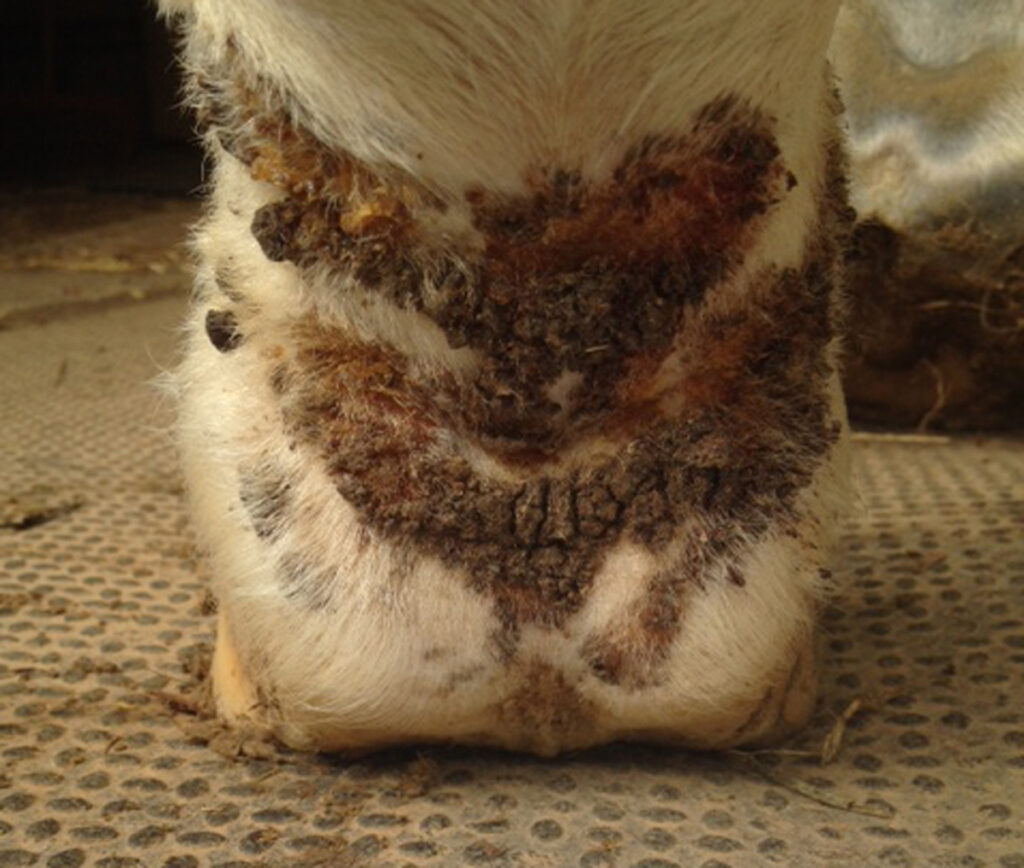Equine pastern dermatitis (EPD) is a cutaneous reaction that better fits a syndrome, rather than a specific disease entity. From a confusing point of view there are numerous lay terms to describe pastern dermatitis, typically based on severity and chronicity. These include terms such as ‘scratches‘, ‘mud fever‘, ‘mud rash‘, ‘greasy heel‘, and ‘dew poisoning‘. There are a number of predisposing, primary and perpetuating factors that all contribute to the syndrome. Needless to say, pastern dermatitis is a difficult condition to manage and is a source of frustration from many owners and vets.

Predisposing factors include non-pigmented skin and hair, draft horse feathers, an environment with high moisture, poor hygiene, and alkaline soils.
Primary factors that thrive on predisposing factors include physical and chemical irritants (treated shavings, creosote, topical blisters), infectious agents, parasites (Chorioptes mites, Trombiculid mites), immune-mediated factors (vasculitis, contact hypersensitization/dermatitis, photosensitization) and proliferative lesions (sarcoids, fungal granulomas).
Perpetuating factors include persistent bacterial and fungal infections (Staphylococcus, Dermatophilus, Malassezia), on-going trauma (insect bites), and environmental factors (cold temperatures, moisture, exposure to sunlight/UV light).
Signs
All breeds can be affected but the condition is more common in horses with thick hair coverage and/or feathers. The back of the pastern is the most common site of involvement, and the back feet are more commonly affected than the fore feet. In most horses the lesions are similar between left and right feet.
The initial changes include swelling of tissue (oedema), reddening, and scaling. Exudation with matting of the hair and the formation of crusts follows. This provides a very good environment for invading bacteria and fungi. Chronically affected horses have thickened skin, with crusts and cracks (fissures).
Lesions are commonly painful and affected horses may appear stiff or overtly lame.
Typically there are 3 presentation of equine pastern dermatitis, classified according to severity and chronicity.
- Mild form – also known as ‘mud fever‘ or ‘scratches‘. This is the most common form seen in practice and is characterised by hair loss, dry scales and crusts. Thickening may be present.
- Exudative form – also known as ‘greasy heel‘ or ‘dew poisoning‘. As the name suggests this form is characterised by exudation. It typically involves skin reddening, alopecia, and a moist crusting dermatitis.
- Chronic proliferative form – also known as ‘grapes‘ or ‘verrucous pododermatitis‘. This form is characterised by excessive granulation tissue that can become cornified. Skin fissures, cracks and papillomatous regions can develop. This form occurs more commonly in draft breeds.
Diagnosis
The diagnosis is typically based on history and examination of the lesions. Although most are seen in the mild stage of the syndrome it may still be very difficult to determine precise causes. A biopsy for histopathology and culture may be helpful, as may fungal culture of hairs and culture for Dermatophilus congolensis.
Treatment
Treatment is very difficult which can be frustrating for all. The focus is to remove as many predisposing factors as possible, for example, move the horse to a dry area is ideal. Clip the affected region, then clean with antibacterial shampoo gently trying to raise and eliminate any crusts. Keeping the area clean and dry is difficult, the product made by Sox for Horses could be helpful, although I haven’t used it as yet.
Topical therapies may be helpful, including an antibiotic and cortisone cream (Prednoderm, Jurox). An older therapy is ‘White Lotion‘ or ‘Yellow Lotion‘, which includes zinc sulphate and lead acetate and acts as an astringent. Parenteral antibiotics can be used in severe cases.
Unfortunately, many cases are difficult to treat, and if successful reoccurrence rates are high.
Tags: Dermatology
